[转] KVM Internals, code and more
KVM
Kernel-based Virtual Machine
Internals, code and more
http://slides.com/braoru/kvm#/
KVM in 5 secondes
- Introduced to make VT-x/AMD-V available to user space
- Exposes virtualization features securely through a single interface
- /dev/kvm
- vailable since 2.6.20 (2006)
- Clean and efficient dev From first LKML posting to merge: 3 months
- 100% orthogonal to core kernel
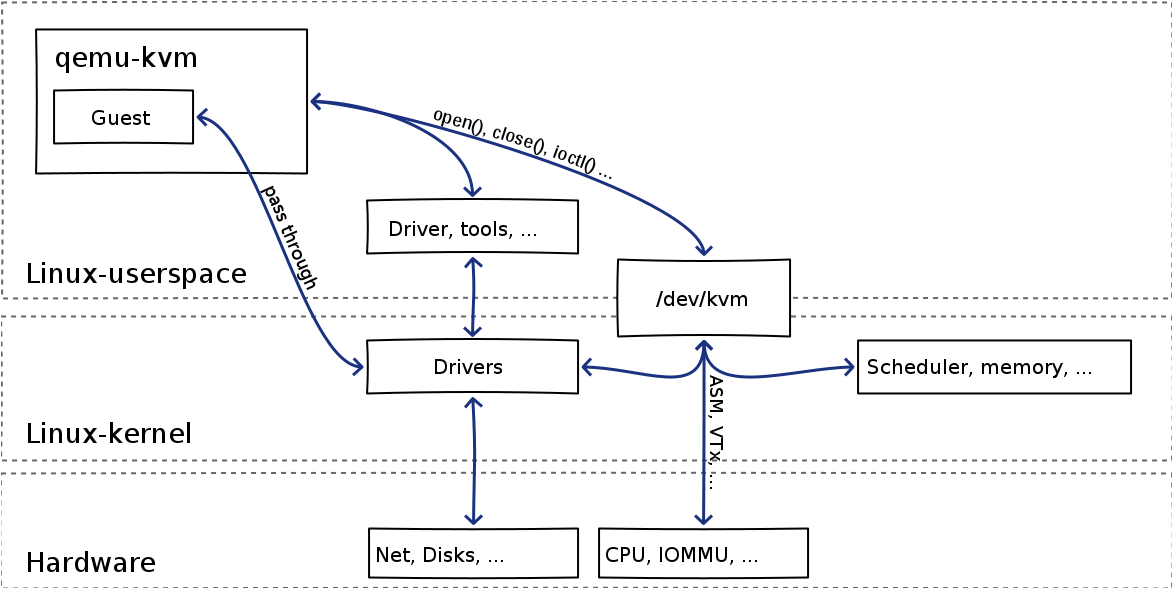
KVM is not KVM
First of all there is QEMU then KVM then Libvirt then the whole ecosystems..
At the begining, Qemu
- Running a guest involves executing guest code
- Handling timers
- Processing I/O
- Responding to monitor commands.
- Doing all these things at once without pausing guest execution
Deal with events
Deal with events
There are two popular architectures for programs that need to respond to events from multiple sources
DEAL WITH EVENTS
Parallel architecture
Splits work into processes or threads that can execute simultaneously.
DEAL WITH EVENTS
Event-driven architecture
Event-driven architecture reacts to events by running a main loop that dispatches to event handlers.
This is commonly implemented using the select(2) or poll(2) family of system calls to wait on multiple file descriptors.
Threading and event driven model of qemu
Qemu uses an hybrid architecture
Qemu the event_loop
- Event-driven architecture is centered around the event loop which dispatches events to handler functions. QEMU's main event loop is main_loop_wait()
- Waits for file descriptors to become readable or writable. File descriptors are a critical because files, sockets, pipes, and various other resources are all file descriptors.
- Runs expired timers.
- Runs bottom-halves (BHs), which used to avoid reentrancy and overflowing the call stack.
QEMU THE EVENT_LOOP
A file descriptor becomes ready, a timer expires, or a BH is scheduled, the event loop invokes a callback
- No other core code is executing at the same time so synchronization is not necessary
- Execute sequentially and atomically
- Only 1 thread of control needed at any given time
- No blocking system calls or long-running computations should be performed.
- Avoid spending an unbounded amount of time in a callback
- If you not follow those advices this will force the guest to pause and the monitor to become unresponsive.
QEMU threads
To help the event_loop
Offload what need to be offloaded
QEMU THREADS
TO HELP THE EVENT_LOOP
- There are system calls which have no non-blocking equivalent.
- Sometimes long-running computations flood the CPU and can't be easily break up into callbacks.
- In these cases dedicated worker threads can be used to carefully move these tasks out of core QEMU.
- One example of worker threads is vnc-jobs.c
- When a worker thread needs to notify core QEMU, a pipe or a qemu_eventfd() file descriptor is added to the event loop.
executing guest code
Here are two mechanism for executing guest code: Tiny Code Generator (TCG) and KVM
Executing guest code in qemu is very simple, it use thread.
Exactly 1 thread by vcpu.
summary about qemu processing
- 1 process per guest
- 1 thread for the main event_loop()
- 1 thread by vcpu
- As many (reasonably) threads as needed for offloaded tasks
All the existing Linux strengths at our disposal
Memory as Huge page, KSM, IO, Scheduler, Energy, Device hotplug, networking, Security, All the Linux software world, ...
qemu guest memory
Guest ram is allocated at qemu start up
This mapped memory is "really" allocated by the process (with malloc())
Tips : use -mem-path to give qemu a memory image to load (can be very very good in #infosec)
reminder
why x86 virt is a pain...
- No hardware provisions
- Instruction behave differently depending on privilege context
- Architecture not built for trap and emulate
- CISC is ... CISC
A complete theorical virtualisation courses : CS 686: Special Topic: Intel EM64T and VT Extensions (Spring 2007)
reminder
how intel vt-x help
Guest SW <-> VMM Transitions
Virtual-machine control structure
KVM virtualisation
KVM is a virtualization feature in the Linux kernel that lets you safely execute guest code directly on the host CPU
- open /dev/kvm
- use iocrl KVM_RUN (KVM IOCTL doc)
As simple as :
open("/dev/kvm")
ioctl(KVM_CREATE_VM)
ioctl(KVM_CREATE_VCPU)
for (;;) {
ioctl(KVM_RUN)
switch (exit_reason) {
case KVM_EXIT_IO: /* ... */
case KVM_EXIT_HLT: /* ... */
}
}
kvm virtualisation
It's DEMO time
What do you need :
- A bit of C ...
- A touch of ASM
- Makefile
- gcc
EMU / KVM / CPU / TIME interactions
Light vs Heavy exit

QEMU / KVM / CPU / TIME interactions
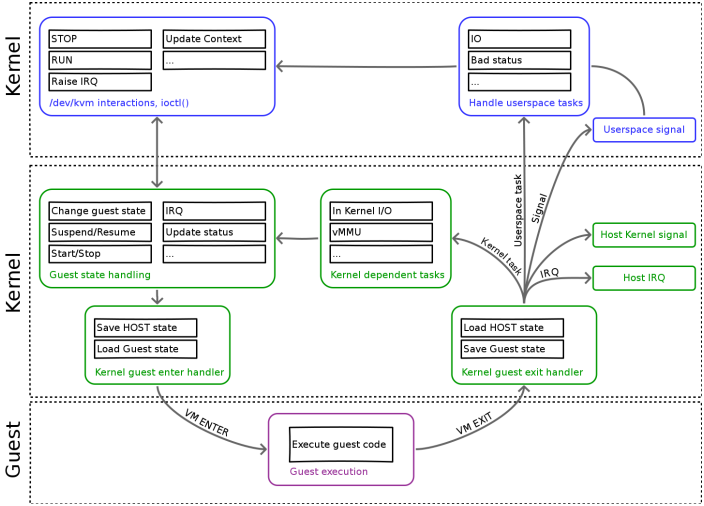
causes of VM Exits
VM Entry :
- Transition from VMM to Guest
- Enters VMX non-root operation
- Loads Guest state and Exit criteria from VMCS
- VMLAUNCH instruction used on initial entry
- VMRESUME instruction used on subsequent entries
VM Exit :
- VMEXIT instruction used on transition from Guest to VMM
- Enters VMX root operation
- Saves Guest state in VMCS
- Loads VMM state from VMCS
start a kvm vm in reality
A bit more complicated than before :
- KVM CREATE VM : The new VM has no virtual cpus and no memory
- KVM SET USER MEMORY REGION : MAP userspace memory for the VM
- KVM CREATE IRQCHIP / ...PIT KVM CREATE VCPU : Create hardware component and map them with VT-X functionnalities
- KVM SET REGS / ...SREGS / ...FPU / ... KVM SET CPUID / ...MSRS / ...VCPU EVENTS / ... KVM SET LAPIC : hardware configurations
- KVM RUN : Start the VM
start a vm in qemu-kvm
/usr/bin/qemu-kvm -S -M pc-0.13 -enable-kvm -m 512 -smp 2,sockets=2,cores=1,threads=1
-name test -uuid e9b4c7be-d60a-c16e-92c3-166421b4daca -nodefconfig -nodefaults
-chardev socket,id=monitor,path=/var/lib/libvirt/qemu/test.monitor,server,nowait
-mon chardev=monitor,mode=readline -rtc base=utc -boot c
-drive file=/var/lib/libvirt/images/test.img,if=none,id=drive-virtio-disk0,boot=on,format=raw
-device virtio-blk-pci,bus=pci.0,addr=0x5,drive=drive-virtio-disk0,id=virtio-disk0
-drive if=none,media=cdrom,id=drive-ide0-1-0,readonly=on,format=raw
-device ide-drive,bus=ide.1,unit=0,drive=drive-ide0-1-0,id=ide0-1-0
-device virtio-net-pci,vlan=0,id=net0,mac=52:54:00:cc:1c:10,bus=pci.0,addr=0x3
-net tap,fd=59,vlan=0,name=hostnet0 -chardev pty,id=serial0 -device isa-serial,chardev=serial0
-usb -device usb-tablet,id=input0 -vnc 127.0.0.1:0 -vga cirrus -device AC97,id=sound0,bus=pci.0,addr=0x4
-device virtio-balloon-pci,id=balloon0,bus=pci.0,addr=0x6
Now you really know why tools are great
KVM processing
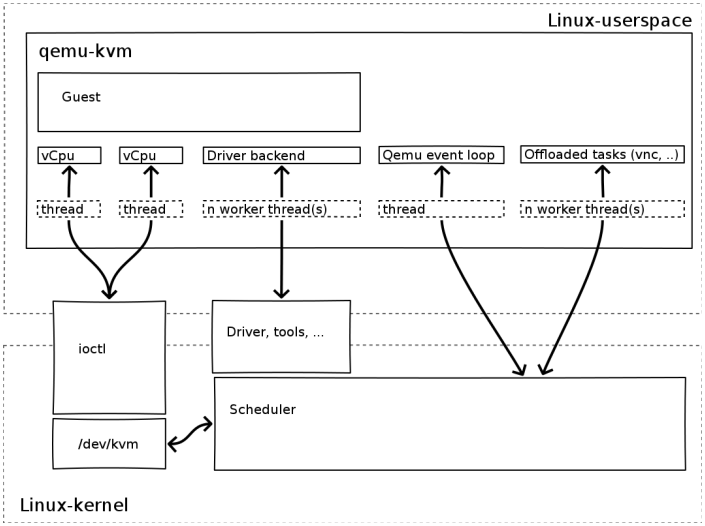
What about passthroug, paravirt and virtio
Reduce VM exits or make them lightweight
Improve I/O throughput & latency (less emulation)
Compensates virtualization effects
Enable direct host-guest interaction
VIRTIO device
- Network
- Block
- Serial I/O (console, host-guest channel, ...)
- Memory balloon
- File system (9P)
- SCSI
Based on generic RX/TX buffer
Logic distributed in the guest driver (aka virtual device) and qemu backend (and kernel backend in some cases)
Virtio device
vhost example
- High throughput
- Low latency guest networking
Normally the QEMU userspace process emulates I/O accesses from the guest.
Vhost puts virtio emulation code into the kernel
- Dont forget vhost-blk and vhost-scsi
Virtio
vhost example
- vhost-net driver creates a /dev/vhost-net character device on the host
- QEMU is launched with -netdev tap,vhost=on and open /dev/vhost-net
- vhost driver creates a kernel thread called vhost-$pid
- $pid = pidof(QEMU)
- Job of the worker thread is to handle I/O events and perform the device emulation.
- vhost architecture is not directly linked to KVM
- Use ioeventfd and irqfd
Virtio device
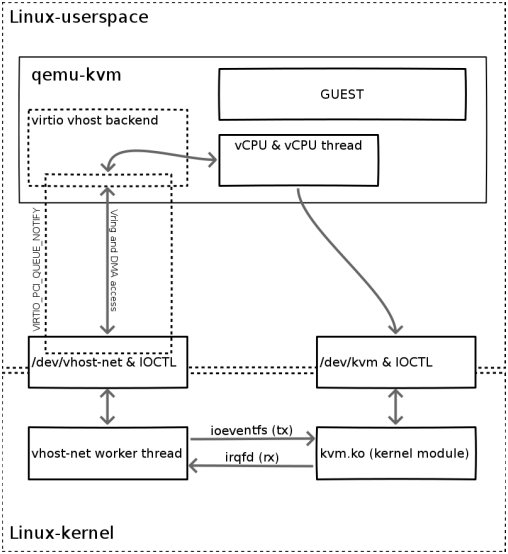
Virtio device
vhost
Kernel code :
- drivers/vhost/vhost.c - common vhost driver code
- drivers/vhost/net.c - vhost-net driver
- virt/kvm/eventfd.c - ioeventfd and irqfd
The QEMU userspace code shows how to initialize the vhost instance :
- hw/vhost.c - common vhost initialization code
- hw/vhost_net.c - vhost-net initialization
LIBVIRT
very small introduction
- Virtualization library: manage guest on one or many nodes
- Share the application stack between hypervisors
- Long term stability and compatibility of API and ABI
- Provide security and remote access “out of the box”
- Expand to management APIs (Node, Storage, Network)
livirt
Very small introduction
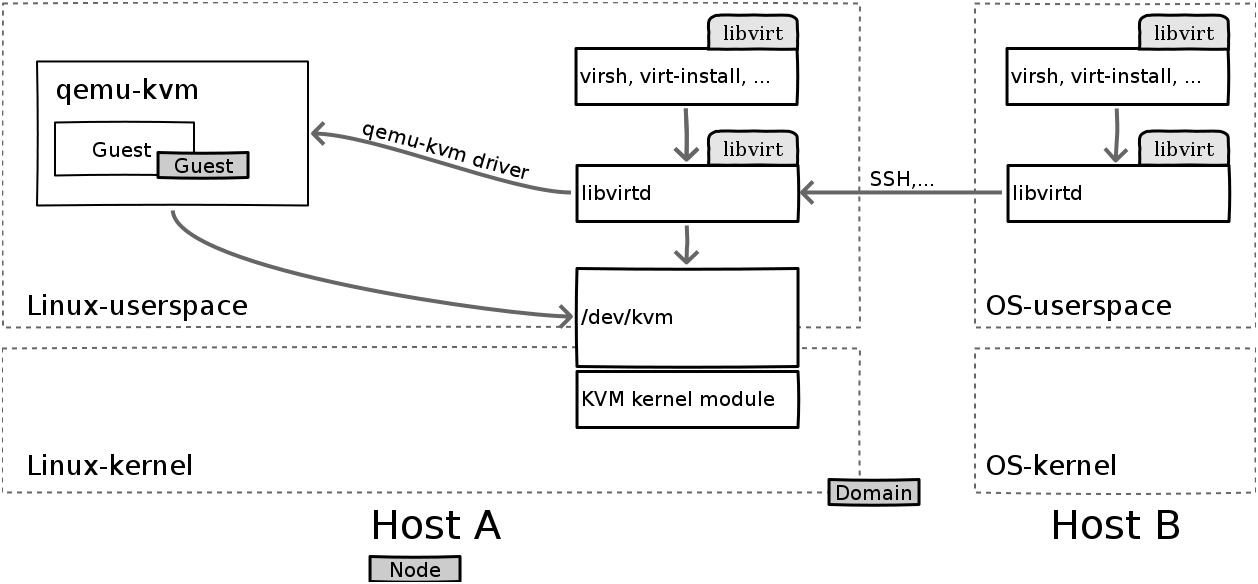
[转] KVM Internals, code and more的更多相关文章
- [转] KVM虚拟化技术生态环境介绍
KVM虚拟化技术生态环境介绍 http://xanpeng.github.io/wiki/virt/kvm-virtulization-echosystem-intro.html kvm和qemu/q ...
- qemu kvm 虚拟化
虚拟化: KVM是一个基于Linux内核的虚拟机,属于完全虚拟化.虚拟机监控的实现模型有两类:监控模型(Hypervisor)和宿主机模型(Host-based).由于监控模型需要进行处理器调度,还需 ...
- <Mastering KVM Virtualization>:第二章 KVM内部原理
在本章中,我们将讨论libvirt.QEMU和KVM的重要数据结构和内部实现.然后,我们将深入了解KVM下vCPU的执行流程. 在这一章,我们将讨论: libvirt.QEMU和KVM的内部运作方式. ...
- [原] KVM 虚拟化原理探究(2)— QEMU启动过程
KVM 虚拟化原理探究- QEMU启动过程 标签(空格分隔): KVM [TOC] 虚拟机启动过程 第一步,获取到kvm句柄 kvmfd = open("/dev/kvm", O_ ...
- 重读 code complete 说说代码质量
重读code complete 说说代码质量 2014年的第一篇文章本来计划写些过去一年的总结和新年展望,但是因为还有一些事情要过一阵才能完成,所以姑且不谈这个,说说最近重读code complete ...
- KVM 介绍(8):使用 libvirt 迁移 QEMU/KVM 虚机和 Nova 虚机 [Nova Libvirt QEMU/KVM Live Migration]
学习 KVM 的系列文章: (1)介绍和安装 (2)CPU 和 内存虚拟化 (3)I/O QEMU 全虚拟化和准虚拟化(Para-virtulizaiton) (4)I/O PCI/PCIe设备直接分 ...
- Following a Select Statement Through Postgres Internals
This is the third of a series of posts based on a presentation I did at the Barcelona Ruby Conferenc ...
- Flink Internals
https://cwiki.apache.org/confluence/display/FLINK/Flink+Internals Memory Management (Batch API) In ...
- Windows Internals学习笔记(五)Synchronization
参考资料: 1. <Windows Internals> 2. 自旋锁spinlock剖析与改进 3. Lock指令前缀 4. Lock指令前缀(二) 5. Kernel Dispatch ...
随机推荐
- where T : class的含义
public class Reflect<T> where T : class { 这是参数类型约束,指定T必须是Class类型. .NET支持的类型参数约束有以下五种:where T : ...
- Linux守护进程实现程序只运行一次
1.守护进程 守护进程(Daemon)是一种运行在后台的特殊进程,它独立于控制终端并且周期性的执行某种任务或等待处理某些发生的事件. 2.让程序只运行一次 如果让程序只运行一次,有很多方法,此处的一种 ...
- java之AbstractStringBuilder类详解
目录 AbstractStringBuilder类 字段 构造器 方法 public abstract String toString() 扩充容量 void expandCapacity(in ...
- 泛函编程(16)-泛函状态-Functional State
初接触泛函状态觉着很不习惯.主要是在使用State数据类型时很难理解其中的原理,特别是泛函状态变迁机制(state transition mechanism):怎么状态就起了变化,实在难以跟踪.我想这 ...
- PHP学习笔记:伪静态规则的书写
这里以阿帕奇为服务器软件,直接上案例: 1.把index.html重定向到index.php RewriteEngine On Options -Indexes ReWriteRule ^index. ...
- bootstrap dialog自行控制窗口的关闭
在使用dialog的时候,我们通常不希望点击btn的时候自动隐藏dialog,通常需要做一些清理或者ajax操作,在bootstrap dialog中,这是通过 data-dismiss=" ...
- Selenium&EmguCV实现爬虫图片识别
概述 爬虫需要抓取网站价格,与一般抓取网页区别的是抓取内容是通过AJAX加载,并且价格是通过CSS背景图片显示的. 每一个数字对应一个样式,如'p_h57_5' .p_h57_5 { backgrou ...
- pace.js和NProgress.js两个加载进度插件的一点小总结
这两个插件都是关于加载进度动画的,应该说各有特点吧,最起码对我来说是各有优势的.今天一天就捣鼓了加载进度动画,也研究了大量的(也就这两个)加载进度动画,也算对加载进度动画有了一个初步的了解了吧. NP ...
- 字母排序问题(c++实现)
描述:编写一个程序,当输入不超过60个字符组成的英文文字时,计算机将这个句子中的字母按英文字典字母顺序重新排列,排列后的单词的长度要与原始句子中的长度 相同.例如: 输入: THE PRICE OFB ...
- javascript --- 子对象访问父对象的方式
在传统面向对象的编程语言里,都会提供一种子类访问父类的特殊语法,引文我们在实现子类方法往往需要父类方法的额外辅助.在这种情况下,子类通常会调用父类中的同名方法,最终以便完成工作. javascript ...
